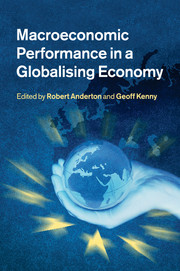Book contents
- Frontmatter
- Contents
- List of figures
- List of tables
- Notes on contributors
- Foreword by Jürgen Stark
- Acknowledgements
- 1 Globalisation and macroeconomic performance
- 2 The impact of globalisation on the euro area macroeconomy
- 3 Trade and foreign direct investment in business services: a modelling approach
- 4 Entry dynamics and the decline in exchange-rate pass-through
- 5 Does the exchange rate belong in monetary policy rules? New answers from a DSGE model with endogenous tradability and trade frictions
- 6 Globalisation and inflation in the OECD economies
- 7 Globalisation and euro area prices and labour markets: some evidence on the impact of low-cost countries
- 8 Monetary policy strategy in a global environment
- 9 Monetary policy in a global economy: past and future research challenges
- Index
- References
2 - The impact of globalisation on the euro area macroeconomy
Published online by Cambridge University Press: 04 February 2011
- Frontmatter
- Contents
- List of figures
- List of tables
- Notes on contributors
- Foreword by Jürgen Stark
- Acknowledgements
- 1 Globalisation and macroeconomic performance
- 2 The impact of globalisation on the euro area macroeconomy
- 3 Trade and foreign direct investment in business services: a modelling approach
- 4 Entry dynamics and the decline in exchange-rate pass-through
- 5 Does the exchange rate belong in monetary policy rules? New answers from a DSGE model with endogenous tradability and trade frictions
- 6 Globalisation and inflation in the OECD economies
- 7 Globalisation and euro area prices and labour markets: some evidence on the impact of low-cost countries
- 8 Monetary policy strategy in a global environment
- 9 Monetary policy in a global economy: past and future research challenges
- Index
- References
Summary
Introduction
With a growing interconnectedness of economies through trade, production and financial market channels, globalisation has become an increasingly important phenomenon over the last decade. Indeed, more recently, the increased integration of economies across the globe in both financial and product markets related to the rapid growth of globalisation has also been associated with global financial turmoil and the highly internationally synchronised nature of the most recent global economic downturn. However, taking a longer-term perspective, what distinguishes the rapid growth of globalisation over the past decade has not been falling transport costs or tariffs alone – a process which has been ongoing for decades now – but rather new production paradigms enabled by both an expansion of global productive capacity and major technological changes facilitating the access and transfer of goods, services, people and knowledge across borders. In this sense, this latest acceleration of globalisation has been inextricably linked to technological change (and, accordingly, distinguishing between the impact of these two phenomena in practice is very difficult).
The rapidly changing world implied by these forces seems to have influenced a range of developments in advanced and emerging economies alike. This chapter takes a narrow view and focuses exclusively on gauging the macroeconomic impacts for the euro area, although in practice, globalisation has undoubtedly also had several other equally important implications – notably for financial markets and macroeconomic policies.
- Type
- Chapter
- Information
- Macroeconomic Performance in a Globalising Economy , pp. 14 - 72Publisher: Cambridge University PressPrint publication year: 2010
References
- 1
- Cited by

